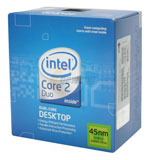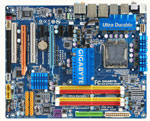Intel Value Midrange
Intel owns the very top in CPU performance with their Core i7, but the Phenom II has made AMD competitive through the upper midrange. That means that midrange is an area where you can now choose Intel or AMD based on the unique features of each platform or expansion capabilities, rather than one brand dominating performance. Since Phenom II is built on a 45nm process, even overclocking capabilities are now competitive with Intel with Phenom II.
The Intel value midrange system builds around a fast Intel Core 2 Duo CPU. For most applications and gaming a faster dual-core CPU is normally a better performance choice that a slower quad-core. CPU intensive applications like video manipulation do benefit from a quad-core CPU, which should be your choice if those applications are important to you. A few recent games are finally taking advantage of quad-core as well, but those are the exception rather than the rule.
| Intel Value Midrange PC | ||
| Hardware | Component | Price |
| Processor | Intel Core 2 Duo E8400 Wolfdale 65W 45nm (3.0GHzx2, 6MB L2) | $165 |
| Cooling | Intel Retail HSF | - |
| Video | PowerColor AX4850 Radeon HD 4850 512MB (after $10 Rebate) | $120 |
| Motherboard | Gigabyte GA-EP45-UD3P (after $20 Rebate) | $115 |
| Memory | 4GB (2x2GB) DDR2-1066 Corsair Twin2X4096-8500C5 5-5-5-15 (after $20 rebate) | $39 |
| Hard Drive | Seagate Barracuda 7200.11 ST31000333AS 1TB | $90 |
| Optical Drive | LG BD/HD DVD / 16x DVD+/- RW GGC-H20LK | $99 |
| Audio | On-Board | - |
| Case | Antec Three Hundred ATX Mid Tower | $55 |
| Power Supply | BFG Tech LS Series LS-550 550W SLI/CrossFire 80 PLUS Certified | $80 |
| Base System Total | $763 | |
| Display | Acer X233Hbid 23" 5ms HDMI Full HD 1080P LCD Monitor (1920x1080) | $190 |
| Speakers | Logitech X-540 70W 5.1 Speakers - Retail | $79 |
| Input | Microsoft CA9-00001 Black PS/2 Standard Keyboard and Optical USB/PS2 Mouse - OEM | $16 |
| Operating System | Microsoft Vista Home Premium OEM | $99 |
| Complete System Bottom Line | $1147 | |
 |
The CPU choice is one of the fastest Core 2 Duo chips with 6MB of L2 cache on the market. The E8400 at 3.00GHz is just two steps below the fastest Core 2 E8600, which clocks at 3.33GHz. It also overclocks exceptionally well, reaching 4GHz and even higher with relative ease. Because of this OC ability, and the value goal of this system build, The E8400 has been matched with components that are also excellent choices for overclocking. The E8400 is plenty fast on its own, but if overclocking interests you this Intel setup will be ready for action - and ready to overclock to wherever your particular E8400 can go.
 |
The big brother to the UD3R selected in our under $800 guide is the $135 Gigabyte GA-EP45-UD3P that has a similar feature set but adds a second x16 slot (in place of a PCI slot) for dual x8 CrossFire operation. You can currently save a few bucks with a $20 mail-in rebate. The board provides an excellent overclocking platform along with great stability. If the second x16 slot is not important to you, we suggest sticking with the UD3R. This P45 chipset motherboard has earned its reputation as a sterling overclocker, while also maintaining excellent stability. It is a good match to the selected Core 2 Duo E8400 or an alternate quad-core Q8200 (2.33GHz 2x3MB L2).
The stock Intel cooler is adequate for modestly overclocking a Core 2 Duo. Better cooling is needed to push the CPU to its capabilities, or if your CPU choice is an Intel quad-core you plan to overclock. The Xigmatek HDT-D1283 120mm Rifle Cooler did very well in our cooling tests and it is a good match to the E8500. OCZ also markets a similar 120 Rifle cooler and either should work well in this system.
For this value midrange system, faster memory with more overclocking head-room was chosen. With the current Corsair rebates some of their best memory is available at truly bargain prices. The choice for the Intel system is a Corsair 4GB DDR2-1066 (PC2-8500) kit. The Corsair Twin X kit specifies fast 5-5-5 timings at DDR2-1066, which is an impressive spec even if you never overclock. Value is good at the normal $59, but with the current $20 rebate the price is a very easy-on-the-budget $39.










73 Comments
View All Comments
7Enigma - Thursday, April 9, 2009 - link
I have the Xigmatek on my recent C2D build and it is fantastic. The pushpin design sucks, but if you opt for them the price is closer to the other more expensive designs (Ultra120, etc.).talozin - Wednesday, April 8, 2009 - link
If the Dark Knight (aka 1283V) is anything like the original 1283, it'll be a superb choice. SPCR reviewed the 1283 and found that it cooled essentially as well as a TRUE while being substantially lighter and cheaper.BPB - Wednesday, April 8, 2009 - link
Thanks. I think I'll pick up one of these puppies.zagood - Wednesday, April 8, 2009 - link
@iAURA: note the addition of monitor, OS, speakers etc. The core system is still around $500.I've been looking at memory a lot lately and I'm surprised by the DDR2 choice. There are other kits out there for around the same A/R price with better timings at lower voltages, just seems like you went with a generic choice, not necessarily the best "bang for the buck" as with the other components.
Wesley Fink - Wednesday, April 8, 2009 - link
I'm extremely puzzled by your comment. If you search DDR2-1066 you will not find a single DDR2 kit at Newegg rated better than the 5-5-5 timings of the OCZ and Patriot DDR2 kits. You CAN find faster DDR2-800 kits, but keep in mind that a 5-5-5 rated DDR2-1066 kit can normally run at much faster timings at DDR2-800. So your comment that faster kits are available is simply not correct.Second, anyone shopping for memory knows that OCZ Reaper, Corsair Dominator, and Patriot' DDR2 are NOT generic memory choices. The kits we selected are good values, but also great memory kits.
You need to UNDERSTAND how memory works - not just compare specs that aren't even apples to apples.
zagood - Wednesday, April 8, 2009 - link
doh! no edit button. re-looked at the pricing and it's not even close to $500 - for the average "enthusiast" though you can usually save on the cost of optical drive, HDDs, etc. pulled from a previous system.Griswold - Wednesday, April 8, 2009 - link
Even (or especially) the 550W for a value mid range is overkill. I'd go for no more than 400W in those and the 550W (at most) in the performance box. CF/SLI "future proofing" is a silly thing to do for most people.poohbear - Wednesday, April 8, 2009 - link
$1800 is midrange??? wow, u sure do have money to burn. That's not mid-term on my salary.:0Wesley Fink - Wednesday, April 8, 2009 - link
As mentioned in the article, if we exclude the stretch to a system with the lowest cost Intel Core i7 our range is $800 to $1600 for a complete system or $740 to $1060 for the basic mid-range box without peripherals. The problem is we would have a difficult time recommending a $1600 Core 2 quad system to a buyer when that is so close to the cost of a well-balanced and better performing Core i7 920 system.We also buy and build systems, so we strongly believe the buying context and competitive environment should be strongly considered in a system purchase. If the $1800 Core i7 system is too rich for you then look at the Value Mid-Range systems at less than $800 for the box and about $1150 for a complete system with US and a 24" 1080p LCD. You may also want to take a look at the recent Under $800 system guide with basic boxes at $300 to $500.
Wesley Fink - Wednesday, April 8, 2009 - link
With OS that is - a complete system with Operating System and LCD monitor and speakers and keyboard/mouse.